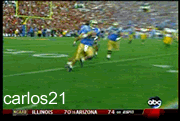
It’s that time again, and the preseason rankings are beginning to flood the pages of college news services. But how accurate is a ranking, and which service is most credible? Of course, I wouldn’t ask the questions, if I didn’t have an answer. The first part of the question is fairly easy for anyone to answer. Preseason polls are an educated guess at the finishing order for the nation’s 25 best. Well, at least they’re supposed to be. There’s very little accuracy from beginning to end, as demonstrated by the need to backtrack to 2004 to find a champion going wire to wire in the polls. But finding the most accurate source isn’t as easy, and who it is and what they’ve projected for 2008 may be surprising.
The hypothesis is based on returning talent, recruiting, coaching stability, and an analysis of spring football. Members of the media will them comprise a list and place the teams in order, based on the aforementioned data. Looking at the past 5 years, if your guess for most accurate source is Sports Illustrated or USA Today polls, you’re wrong. CBS Sportline or Fox News? Wrong again. Since 2003, the top 5 media sources, in terms of preseason poll accuracy, are as follows:
1. Phil Steele
2. Athlon Sports
3t.Lindy’s
3t.Sporting News
5. Street and Smith
In 2007, Athlon Sports’ final finish was nearest to the beginning order than any other news source. But the accumulated scores for the past 5 seasons show Phil Steele to be the most accurate. Knowing this, it has to make you curious of Steele’s 2008 projections. And of course, here they are:
The hypothesis is based on returning talent, recruiting, coaching stability, and an analysis of spring football. Members of the media will them comprise a list and place the teams in order, based on the aforementioned data. Looking at the past 5 years, if your guess for most accurate source is Sports Illustrated or USA Today polls, you’re wrong. CBS Sportline or Fox News? Wrong again. Since 2003, the top 5 media sources, in terms of preseason poll accuracy, are as follows:
1. Phil Steele
2. Athlon Sports
3t.Lindy’s
3t.Sporting News
5. Street and Smith
In 2007, Athlon Sports’ final finish was nearest to the beginning order than any other news source. But the accumulated scores for the past 5 seasons show Phil Steele to be the most accurate. Knowing this, it has to make you curious of Steele’s 2008 projections. And of course, here they are:
Phil Steele’s 2008 Preseason top 25
1. Florida
2. Ohio State
3. Oklahoma
4. USC
5. Clemson
6. West Virginia
7. Missouri
8. South Florida
9. Georgia
10.Penn State
11.Texas Tech
12.Auburn
13.LSU
14.Utah
15.Texas
16.Virginia Tech
17.BYU
18.South Carolina
19.Notre Dame
20.California
21.Wisconsin
22.Oregon
23.Tennessee
24.Florida State
25.Pittsburgh
These rankings definitely are not along the lines of mainstream projections, and certain to spark debate. In trying to figure out why and how this order was determined, I could only think of one thing that would make sense.
To get an order like this one, and also to increase your odds for a more accurate finish, you would have to take team schedules into consideration. If you look at that list, it really isn’t an assessment of the strongest teams to start the year, because I can’t see any realism to Utah having a greater roster and coaching staff than Texas, Virginia Tech, Tennessee, etc. But if you look at the schedules some of these teams play, this could be a realistic look at the end of the season. That would be the difference between Steele and other services. Most rank the beginning order, where Steele includes schedules in the equation to guess the end. There is no certainty to that, but that’s my guess, at least.
To get an order like this one, and also to increase your odds for a more accurate finish, you would have to take team schedules into consideration. If you look at that list, it really isn’t an assessment of the strongest teams to start the year, because I can’t see any realism to Utah having a greater roster and coaching staff than Texas, Virginia Tech, Tennessee, etc. But if you look at the schedules some of these teams play, this could be a realistic look at the end of the season. That would be the difference between Steele and other services. Most rank the beginning order, where Steele includes schedules in the equation to guess the end. There is no certainty to that, but that’s my guess, at least.
Make sense?






No comments:
Post a Comment